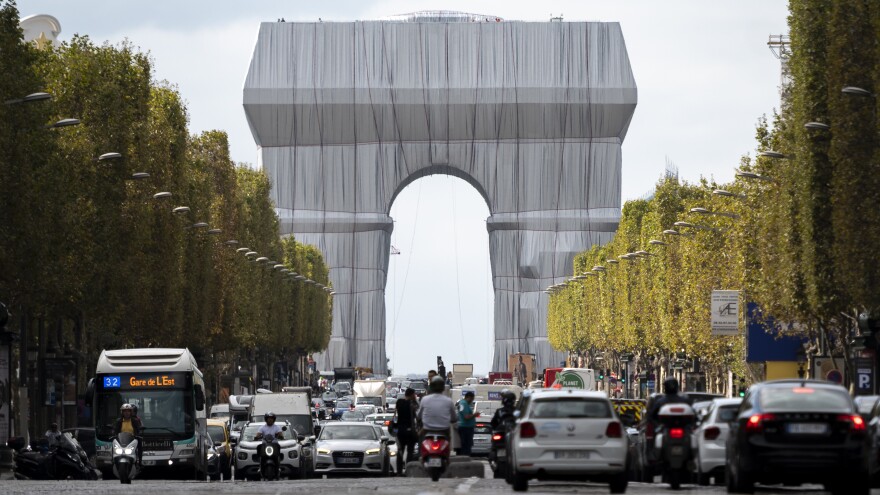Truth matters. Community matters. Your support makes both possible. LAist is one of the few places where news remains independent and free from political and corporate influence. Stand up for truth and for LAist. Make your year-end tax-deductible gift now.
Here's Why The Arc De Triomphe Was Just Wrapped In Fabric

The Arc de Triomphe — the star attraction in the Place de l'Étoile in Paris — is shrouded in fabric today, as a tribute to the late artists Christo and Jeanne-Claude.
It is "a sensual, popular and monumental gesture," according to Carine Rolland, the deputy mayor of Paris in charge of culture.
While the official English name for the project is L'Arc de Triomphe, Wrapped, the French call it L'Arc de Triomphe Empaqueté — using the word for "packaged."
Preparations for the temporary installation took about three months. But a time-lapse video shows that the installation's fabric was unfurled from the top and guided to the bottom of one side of the monument in a single day.
The massive monument is now covered in 25,000 square meters of recyclable polypropylene fabric that is a silver-blue color, along with 3,000 meters of red rope. The installation will remain in place for 16 days, officially running from Sept. 18 to Oct. 3.
"No tickets are needed to see, approach, and touch the work of art," the project website states, adding that "Place de l'Étoile will be closed to vehicular traffic on the weekend for pedestrians to enjoy the work of art."
There is one caveat for anyone hoping to take splashy photos to post on social media: selfie sticks are forbidden in the pedestrian area and the monument. Coronavirus precautions also apply.

The project was 60 years in the making. Christo and Jeanne-Claude began transforming public spaces into their now-famous works of art in 1961, according to the artists' website. Soon afterward, Christo, who became fascinated by the Arc de Triomphe when he lived near the monument, produced a photomontage showing what it might look like wrapped up. Now, the site states, "the project will finally be concretized."

Christo Vladimirov Javacheff and Jeanne-Claude Denat de Guillebon met in Paris in 1958, starting a relationship that led to marriage and one of the world's most famous artistic collaborations. Jeanne-Claude died in 2009; before Christo died in 2020, he asked that the Arc de Triomphe project be completed posthumously.
The project was not as simple as simply closing a large set of drapes. Before the massive curtains could be installed, a small army of climbers and other workers installed scaffolding and brackets around the top of the Arc de Triomphe and parts of its pillars, to protect sculptures and decorative carvings. The brackets also help the material hang uniformly.
If you're curious how the monument looks right now, the artists' website highlights a camera that's trained on the Arc around the clock — the video is livestreaming on YouTube.
The French luminaries who unveiled the art installation on Thursday included Paris Mayor Anne Hidalgo and French President Emmanuel Macron. The two appeared alongside each other less than a week after Hidalgo announced she will challenge Macron in next year's presidential election.
"In Paris, Christo and Jeanne-Claude dreamed of packaging the @ArcDeTriomphe," Hidalgo said via Twitter. She thanked the teams who brought that dream to life — as well as "this couple whose works will remain among the most outstanding of our era."
Copyright 2023 NPR. To see more, visit https://www.npr.org. 9(MDA1OTI3MjQ5MDEyODUwMTE2MzM1YzNmZA004))








